
Why this Research Tool?
When consulting the public for Primary Research, my group unanimously agreed that Quantitative Research would be the most effective type of Primary Research to do on the day.
We decided this because:
1) To make data from Quantitative Research is easily done
2) The public finds Quantitative data a lot less irritating than other forms of data because most of the time there's a multiple choice answer of some sort - therefore, more responses can be obtained
3) It is a lot quicker to consult the public with a Quantitative Research Tool because it is possible to quickly write down the answers, and no detailed answers are required to be recorded
Our Questions;
My group all separately came up with five of our own questions, meaning that all together we had twenty questions (the ones in bold being the ones that I asked);
-
Are you happy with the public transport in this area?
-
Do you think there needs to be more space made for new residencies in this area?
-
Do you find this area liveable?
-
Are you happy with the public areas (eg. parks) in this area?
-
How many people do you live with?
-
Would you like a railway station in this area?
-
Would you like sky rises in this area?
-
Would you live in this area if it were to become a residential area?
-
Would you like a corner store in this area?
-
On a scale of 1 to 5, how necessary is it to have a lot of public parks/areas or foliage in the area?
-
Do you believe that Rozelle would be a prime residential location?
-
Would you like a house that is in the vicinity of a recreational area ie. park ?
-
Out of the four, which do you take the most (Car, Train, Ferry, Bus)
-
Do you believe that this area embraces religions and beliefs and is multiculturally diverse?
-
Would you prefer to live in a house, townhouse, duplex or an apartment?
-
Would you live in a highrise building?
-
Do you think the city is environmentally sustainable?
-
Would you be willing to pay more money for a residency that is on the waterfront, and is around recreational areas?
-
Would you want the harbour waterways to be opened up to the public?
-
Would you like the harbour waterways to be used for recreational purposes?
Results;
Bellow is the tally that was made for the excursion and graphs made from the results:
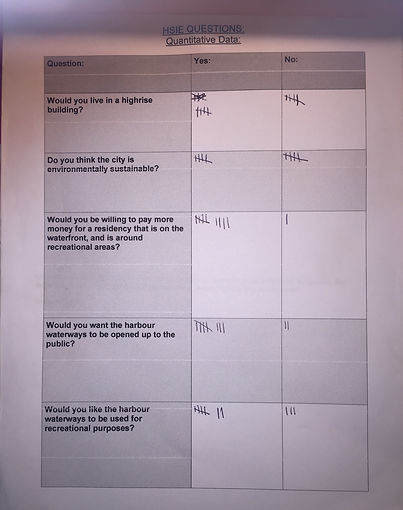
QUANTITATIVE RESEARCH TOOL
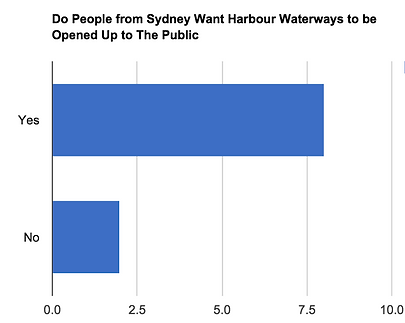
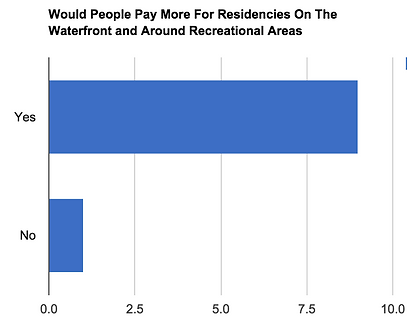
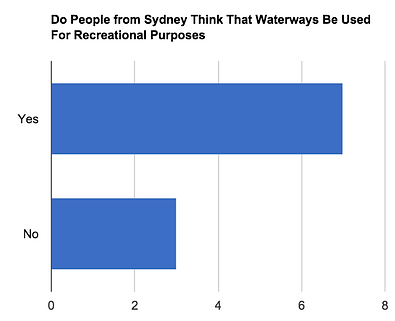
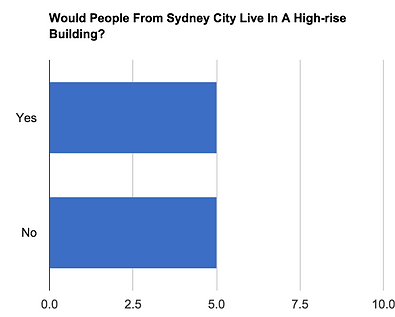

Question: Would you live in a high-rise building?
Answer: Five out of ten people said that they would live in a high-rise building, five out of ten people said that they wouldn't live in a high-rise building.
Question: Do you think the city is environmentally sustainable?
Answer: Five out of ten people said that they thought Sydney City was environmentally sustainable, five out of ten people said that they didn't think that Sydney City was environmentally sustainable.
Question: Would you be willing to pay more money for a residency that is on the waterfront, and is around recreational areas?
Answer: Nine out of ten people said that they would pay more for a recidency that is around recreational areas and/or is on a waterfront, one out of ten people said that they wouldn't pay more.
Question: Would you like the harbour waterways to be used for recreational purposes?
Answer: Seven out of ten people said that they would like the harbour waterways to be used for recreaional purposes, three out of ten people said that they wouldn't like the harbour waterways to be used for recreational purposes.
Question: Would you want the harbour waterways to be opened up to the public?
Answer: Eight out of ten people said that they would like the harbour waterways to be opened up to the public, two out of ten people said that they wouldn't like the harbour waterways to be opened up to the public.